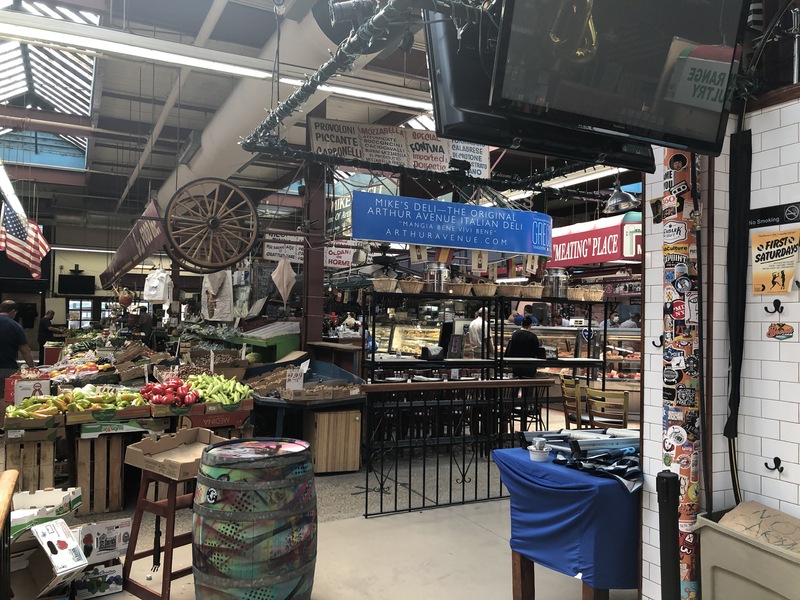Item
A Linguistic Tour through Arthur Avenue
Title (Dublin Core)
A Linguistic Tour through Arthur Avenue
Description (Dublin Core)
I traveled to New York this summer, and one of the places I visited was Arthur Avenue, located in the Belmont neighborhood of the Bronx and the main artery of the Bronx's Little Italy. Arthur Avenue provided a unique insight into the function of immigrant languages during the pandemic.
Most of the people I heard talking as I walked down Arthur Avenue and went into the stores were speaking English, as would be expected in most of the United States. Some had an accent similar to a "standard" American accent/my Californian accent, while others spoke in New Yorker accents. I heard some people speaking Italian, mostly if not entirely elderly people, in several stores, including Cerini Coffee and Gifts. I also heard expression of language through music, in the form of a speaker in front of Mario's Restaurant playing "Tu vuò fà l'Americano" ("You Want to Be an American") and "O Sarracino" ("The Saracen"), two famous Neapolitan language songs. I didn't expect to hear music in Italian "dialect" (called so even though Neapolitan is a proper stand-alone language).
However, Belmont is no longer just Little Italy. It also has a large Albanian presence. I saw a flyer on a street pole in Albanian which I presume to either be a missing sign or a flyer for a funeral. I have no idea what the flyer said because I don't know Albanian, but among the text were two pictures of an elderly man. In front of Randazzo's Seafood, I also saw a sign advertising some type of shellfish (I can't remember which) in Albanian and English, though not in Italian, which I thought was interesting since the store is owned by the grandchildren of immigrants from Sicily. There was also an Albanian television provider called TV ALB, which indicated to me that there are enough Albanian speakers in the area to sustain an Albanian-language cable or broadcast provider, even during the pandemic. I didn't hear any spoken Albanian.
This could be a purely anecdotal observation, but I saw Italian primarily as a spoken language and Albanian primarily in writing. There was some writing in Italian, but most of it was either names of food items that couldn't be translated into English or sayings like "mangia bene vivi bene" ("eat well, live well", as a command; the picture of which is attached to this story) for promotional purposes. There was no actual communication occurring in written Italian.
On a non-linguistic note, most of the restaurants also had outdoor seating under canopies, a consequence of COVID.
Most of the people I heard talking as I walked down Arthur Avenue and went into the stores were speaking English, as would be expected in most of the United States. Some had an accent similar to a "standard" American accent/my Californian accent, while others spoke in New Yorker accents. I heard some people speaking Italian, mostly if not entirely elderly people, in several stores, including Cerini Coffee and Gifts. I also heard expression of language through music, in the form of a speaker in front of Mario's Restaurant playing "Tu vuò fà l'Americano" ("You Want to Be an American") and "O Sarracino" ("The Saracen"), two famous Neapolitan language songs. I didn't expect to hear music in Italian "dialect" (called so even though Neapolitan is a proper stand-alone language).
However, Belmont is no longer just Little Italy. It also has a large Albanian presence. I saw a flyer on a street pole in Albanian which I presume to either be a missing sign or a flyer for a funeral. I have no idea what the flyer said because I don't know Albanian, but among the text were two pictures of an elderly man. In front of Randazzo's Seafood, I also saw a sign advertising some type of shellfish (I can't remember which) in Albanian and English, though not in Italian, which I thought was interesting since the store is owned by the grandchildren of immigrants from Sicily. There was also an Albanian television provider called TV ALB, which indicated to me that there are enough Albanian speakers in the area to sustain an Albanian-language cable or broadcast provider, even during the pandemic. I didn't hear any spoken Albanian.
This could be a purely anecdotal observation, but I saw Italian primarily as a spoken language and Albanian primarily in writing. There was some writing in Italian, but most of it was either names of food items that couldn't be translated into English or sayings like "mangia bene vivi bene" ("eat well, live well", as a command; the picture of which is attached to this story) for promotional purposes. There was no actual communication occurring in written Italian.
On a non-linguistic note, most of the restaurants also had outdoor seating under canopies, a consequence of COVID.
Date (Dublin Core)
Creator (Dublin Core)
Contributor (Dublin Core)
Type (Dublin Core)
text story
photo
Controlled Vocabulary (Dublin Core)
Curator's Tags (Omeka Classic)
Contributor's Tags (a true folksonomy) (Friend of a Friend)
Collection (Dublin Core)
Date Submitted (Dublin Core)
06/27/2021
Date Modified (Dublin Core)
06/29/2021
Item sets
This item was submitted on June 27, 2021 by Nicholas Harvey using the form “Share Your Story” on the site “A Journal of the Plague Year”: https://covid-19archive.org/s/archive
Click here to view the collected data.
